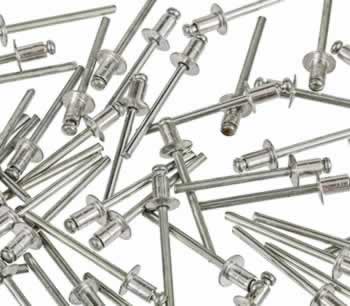Drive Rivets
Welcome to our comprehensive product description for Drive Rivets. In this guide, we will explore the world of these secure and efficient fastening solutions that are widely used in various industries and applications. Drive rivets, also known as drive pins or hammer drive rivets, are unique fasteners that offer a simple and effective method for joining two or more materials together. They provide a permanent and tamper-resistant connection, making them ideal for applications where vibration resistance and durability are essential. With their ease of installation and excellent load-bearing capabilities, drive rivets are a preferred choice for various projects.
Key Features and Benefits
Drive rivets offer a wide range of features and benefits that make them indispensable in different scenarios. Let's explore some of their key advantages:
- Quick Installation: Drive rivets can be installed quickly using a hammer or pneumatic rivet gun, reducing assembly time.
- High Strength: These rivets form a strong and reliable joint, providing excellent load-bearing capabilities.
- Tamper-Resistant: Once installed, drive rivets cannot be easily removed, providing added security.
- Cost-Effective: Drive rivets provide a cost-effective solution for fastening materials without the need for specialized equipment.
- Wide Range of Materials: Drive rivets are available in various materials, including steel, aluminum, and stainless steel, offering options for different applications.
- Compact Design: These rivets have a low profile and do not require a backside clearance, making them suitable for tight spaces.
- One-Sided Installation: Drive rivets can be installed from one side of the workpiece, making them ideal for applications with limited access.
- Wide Grip Range: Drive rivets can accommodate different material thicknesses, providing flexibility in assembly.
- Corrosion Resistance: Stainless steel and other materials offer excellent resistance to corrosion, ensuring durability in harsh environments.
- Various Head Styles: Drive rivets are available with different head styles, such as round, flat, and countersunk, for specific application requirements.
Types of Drive Rivets
Drive rivets come in various types, each designed for specific functions and applications. Some common types include:
- Round Head Drive Rivets: These rivets have a rounded head, providing a neat appearance and even distribution of load.
- Flat Head Drive Rivets: Also known as countersunk drive rivets, they have a head that sits flush with the workpiece surface for a smooth finish.
- Hex Head Drive Rivets: These rivets have a hexagonal head, allowing for easy installation with a wrench or socket.
- Oval Head Drive Rivets: These rivets have an oval-shaped head, providing a unique aesthetic appeal to the assembly.
Materials and Finishes
Drive rivets are available in a variety of materials, each offering specific properties suitable for different applications. Some common materials include:
- Steel: Steel drive rivets offer high strength and durability, making them suitable for various heavy-duty applications.
- Stainless Steel: Stainless steel drive rivets provide excellent corrosion resistance, making them ideal for outdoor and marine applications.
- Aluminum: Aluminum drive rivets are lightweight and non-magnetic, often used in aerospace and automotive applications.
Additionally, drive rivets may feature various finishes such as zinc plating, black oxide coating, or passivation, providing enhanced corrosion resistance and aesthetics.
Applications
Drive rivets find widespread use in various industries and applications. Some common applications include:
- Construction: Used in building and construction projects for securing metal frames, panels, and brackets.
- Automotive: Found in automotive assemblies, from body panels to interior components, for secure fastening.
- Electronics: Utilized in electronic enclosures and components for joining metal or plastic parts.
- Furniture: Used in furniture assembly for attaching metal or wood components.
- Appliances: Found in household appliances for fastening metal casings and components.
- Signage and Displays: Utilized in signage and display fabrication for securing panels and frames.
- Marine: Used in marine applications for securing equipment and structures on boats and ships.
- Telecommunications: Found in networking and communication equipment for securing racks and panels.
Installation Process
The installation of drive rivets involves a simple process:
- Prepare the Rivet: Select the appropriate drive rivet size and head style for the application.
- Insert the Rivet: Insert the drive rivet into the pre-drilled hole in the workpiece.
- Drive the Rivet: Use a hammer or pneumatic rivet gun to strike the rivet mandrel, expanding the rivet body and creating a secure joint.
- Verification: Check that the drive rivet is securely set and the joint is stable.
Quality Assurance
At OneMonroe, we are committed to delivering high-quality drive rivets that meet or exceed industry standards. Our manufacturing processes undergo rigorous quality control to ensure consistent and reliable products. We prioritize customer satisfaction and strive to be your trusted partner for fastening solutions.
Conclusion
In conclusion, our Drive Rivets offer a reliable and efficient solution for fastening and securing components in a wide range of applications. With their simple and straightforward installation process, these rivets provide a cost-effective and time-saving option for various projects. The drive rivets are designed for one-sided installation, making them suitable for situations where access to the rear side of the assembly is limited. Whether you need fasteners for automotive, construction, or general assembly, our Drive Rivets deliver the strength and durability you require. Experience the ease of installation and dependable performance of our Drive Rivets by exploring our comprehensive range today.










